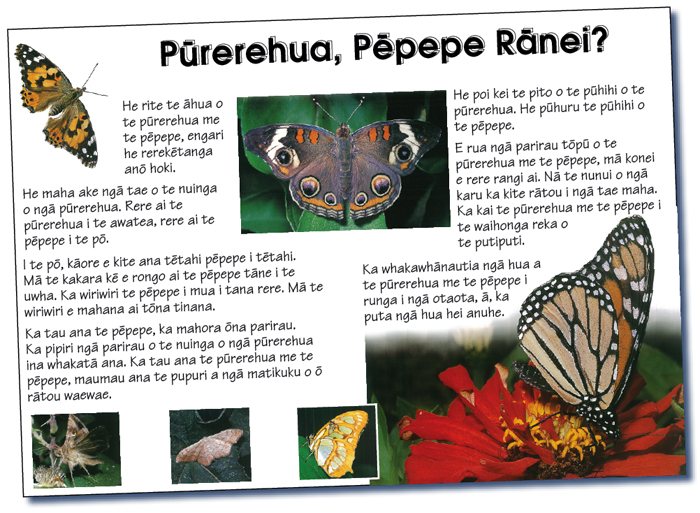| Approach: Station |
 |
304Kb |
|
| Focus:
Comprehending
meaning, analysing |
| Resources: |
A3
poster, computer program on laptop computer |
| Kupu: |
pühuru =
feathery
töpü = pair |
|
|
Questions/instructions:
|
He
mahi rorohiko tënei. Pänuihia te käri i mua i
te whakamahinga i te rorohiko.
Päwhiria te pütohu Pürerehua, Pëpepe Ränei?
Whäia
ngä tohutohu a te rorohiko. |
This
activity uses the computer. Read the poster before you use the
computer.
Click on the button that says Butterfly or Moth?
The computer will tell you what
to do. |
 |
He rite
te ähua o te pürerehua me te pëpepe,
engari he rerekëtanga anö hoki.
He maha ake ngä tae o te nuinga o ngä pürerehua.
Rere ai te pürerehua i te awatea, rere ai te pëpepe i
te pö.
I te pö, käore e kite ana tëtahi pëpepe i tëtahi.
Mä te kakara kë e rongo ai te pëpepe täne i
te uwha. Ka wiriwiri te pëpepe i mua i tana rere. Mä te
wiriwiri e mahana ai töna tinana.
Ka tau ana te pëpepe, ka mahora öna parirau. Ka pipiri
ngä parirau o te nuinga o ngä pürerehua ina whakatä ana.
Ka tau ana te pürerehua me te pëpepe, maumau ana te pupuri
a ngä matikuku o ö rätou waewae.
He poi kei te pito o te pühihi o te pürerehua. He pühuru
te pühihi o te pëpepe.
E rua ngä parirau töpü o te pürerehua me te
pëpepe, mä konei e rere rangi ai. Nä te nunui o
ngä karu ka kite rätou i ngä tae maha. Ka kai te
pürerehua me te pëpepe i
te waihonga reka o
te putiputi.
Ka whakawhänautia ngä hua a
te pürerehua me te pëpepe i
runga i ngä otaota, ä, ka
puta ngä hua hei anuhe. |
Butterfly or Moth?
Butterflies and moths look alike, but there are ways of telling
them apart.
Butterflies are usually more colourful than moths. Butterflies
fly around during the day, while most moths fly at night.
At night, moths cannot use what they look like to find each other.
Instead the male finds the female by her scent. Moths often shiver
before they fly. The shivering helps to warm up their bodies.
When a moth lands it spreads out its wings. Most butterflies rest
with their wings pressed together. When butterflies and moths land
they hold on tight using hooks on their feet.
A butterfly’s antenna has a blob at its end. The antenna
of a moth is feathery.
Both butterflies and moths have 2 pairs of wings, which they use
to fly through the air. They have large eyes that allow them to
see in colour. Butterflies and moths feed on the sugary nectar
made by flowers.
Butterflies and moths lay their eggs on plants. Their eggs hatch
into caterpillars. |
|
| |
%
responses |
| 1. |
E rua ngä töpü parirau o te... |
|
| |
Which
insect has 2 pairs of wings? |
both
|
40 |
| 2. |
Rërere ai a wai i te awatea? |
|
| |
Which
insect comes out in daylight? |
butterfly
|
64 |
| 3. |
Ko
wai te mea ka mahora öna parirau ina whakatä ana? |
|
| |
Which
insect rests with its wings out? |
moth
|
52 |
| 4. |
Ko wai te mea ka kimi te täne i te uwha mä töna kakara? |
|
| |
Which
male insect finds a female by her scent? |
moth
|
60 |
| 5. |
He poi kei te pito o te pühihi... |
|
| |
Which
insect has a blob on the end of its antenna? |
butterfly
|
50 |
| 6. |
Mä öna parirau e rere ai... |
|
| |
Which
insect uses its wings to fly? |
both
|
55 |
| 7. |
Ko
wai te mea ka kai i te waihonga o te putiputi? |
|
| |
Which
insect feeds on flower nectar? |
both
|
50 |
| 8. |
Ko
wai te mea e pipiri ana ngä parirau ina whakatä ana? |
|
| |
Which
insect rests with its wings together? |
butterfly
|
57 |
| 9. |
He pühuru te ähua o ngä pühihi... |
|
| |
Which
insect has feathery antenna? |
moth
|
55 |
| 10. |
Ka puta he anuhe mai i ngä hua... |
|
|
| |
Which
insect has eggs that hatch into caterpillars? |
both
|
43 |
| 11. |
He
matikuku kei ngä waewae o... |
|
| |
Which
insect has hooks on its feet? |
both
|
52 |
| 12. |
Ko wai te mea ka wiriwiri i mua i tana rerenga atu? |
|
| |
Which
insect shivers before it flies? |
moth
|
76 |
| 13. |
Ko wai te mea e kite ana i ngä tae maha? |
|
| |
Which
insect sees in colour? |
both
|
14 |
| 14. |
Ko
wai te mea ke rërere haere i te pö? |
|
| |
Which
insect comes out at night? |
moth |
76 |
| |
Total
score: |
14
|
0 |
| |
12–13
|
10 |
10–11
|
14 |
8–9
|
26 |
6–7
|
19 |
4–5
|
21 |
0–3
|
10 |
Commentary:
Performance was quite
weak on this task, with half of the students answering no more than half
of the questions correctly. The use of the computer to indicate and record
student response may have been a contributing factor to the low scores.
|